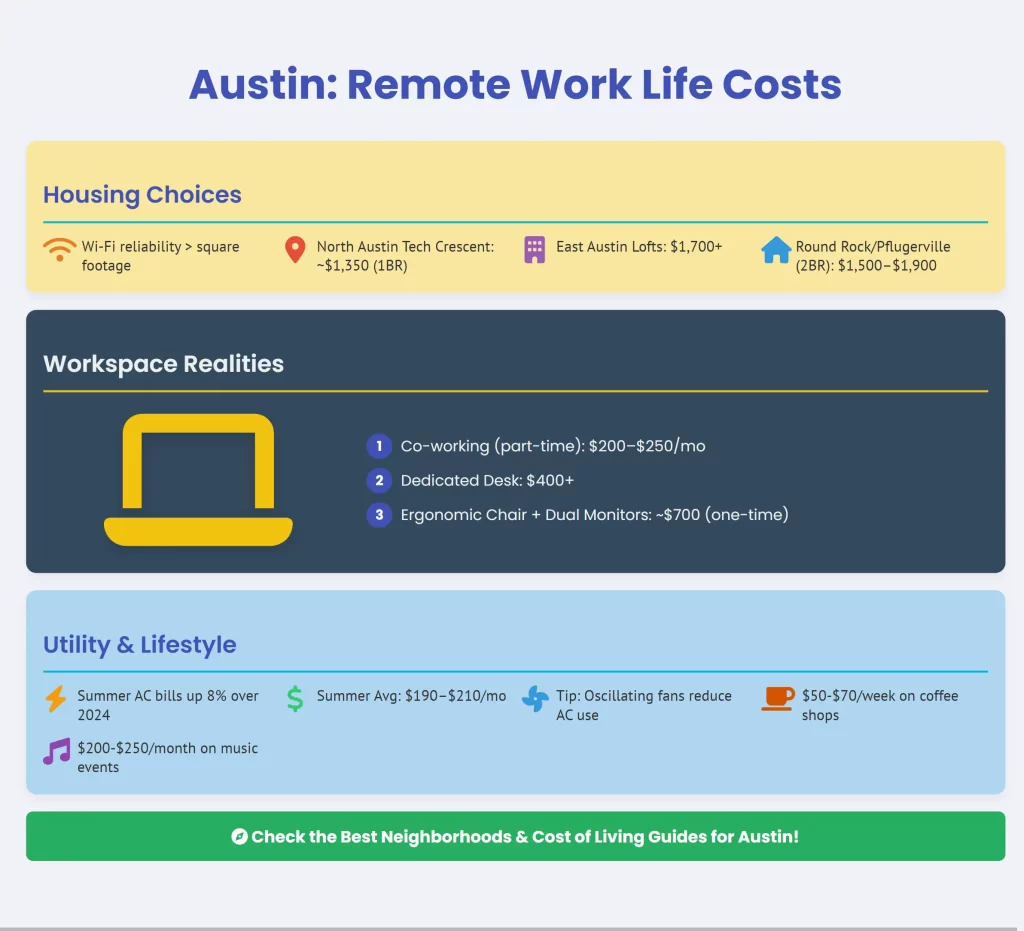Remote work has reshaped Austin more than almost any other economic force. By fall of 2025, thousands of arrivals from across the country stream into the city wearing the badge “remote.” They’re software engineers, designers, analysts, teachers… each bringing a laptop, plugging into Wi‑Fi, and trying to make sense of Austin’s costs.
The challenge: budgets for remote workers don’t map cleanly against local salary averages. There’s no employer‑subsidized cafeteria, no corporate shuttles, and often, no relocation allowances. You’re balancing a steady paycheck from New York, Seattle, or Chicago against a lifestyle cost unique to Austin.
Let’s chart a practical workflow for how to budget wisely if you’re one of these remote newcomers in September 2025.
Net Pay Perspective
Suppose you earn $85,000 remotely, taxed by federal and FICA but free of Texas state income tax.
- Gross monthly: $7,083
- Net monthly (22% fed + 7.65% FICA): ~ $5,300 in pocket
Now let’s build the monthly map targeted specifically for remote life here.
| Category | Baseline 2025 Cost (Solo) | Notes |
|---|---|---|
| Rent (1BR North Austin) | $1,420 | value vs downtown $1,950 |
| Utilities + Wi‑Fi | $280 | includes high‑speed fiber |
| Workspace / Co‑working | $250 avg (part‑time desk) | extras remote workers should plan |
| Transportation | $400 | car + insurance |
| Health Insurance | $365 | TX employer avg, higher on marketplace |
| Groceries | $345 | Austin average per adult |
| Eating Out / Cafes | $380 | especially for remote laptop culture |
| Entertainment / Music | $250 | Austin lifestyle premium |
| Savings Contribution | $600 | ~11% of gross |
Monthly total ≈ $4,290
Leaves $1,010 cushion — workable, but thinner if indulging in nightlife.
Housing Choices

Remote workers often prioritize Wi‑Fi reliability > square footage. Popular zones in 2025:
- North Austin Tech Crescent (cheaper, fiber‑ready): ~$1,350 for 1BR.
- East Austin lofts (creative vibe, rising expense): $1,700+.
- Round Rock / Pflugerville (suburban calm, space for home office): $1,500–$1,900 for 2BR, ideal for dual remote couples.
CTA: Check the Best Neighborhoods in Austin guide to see which clusters align with your work‑home balance.
And for understanding the full picture, explore the Austin cost of living overview.
Workspace Costs
Even with home desks, many crave structured environments. Part‑time co‑working plans: $200–250/mo, full dedicated desks: $400+.
Budget for gear upgrades too:
- Ergonomic chairs for long sessions
- Second monitors for dual‑screen productivity
Set $700 one‑time for proper long‑term setup.
Utility Realities
Remote workers spend more daylight hours at home → higher AC bills. Austin Energy data shows summer 2025 average bills up 8% over 2024. Expect $190–$210 monthly June–Sept, falling to ~$120 in winter.
Mitigation tip: high‑efficiency oscillating fans can trim summer reliance.
Social & Lifestyle Premiums
Remote culture leans into coffee shops and food trucks. Plan $50–$70/week for “second offices” like Radio Coffee or Bennu Coffee. That’s ~$250–$300 monthly just on workspace lattes.
Add Austin’s music pulse: events at Mohawk, ACL Live, or SXSW spillover all year. Average local spends $200–$250 monthly on tickets + drinks.
Comparison: Remote Worker in Austin vs Dallas
| City | 1BR Rent (2025) | Co‑working Desk | Groceries | Monthly Total |
|---|---|---|---|---|
| Austin | $1,470 | $250 | $345 | $4,290 |
| Dallas | $1,320 | $200 | $325 | $3,950 |
| Houston | $1,250 | $220 | $330 | $3,880 |
The Austin “remote worker premium” is ~8–10% above Dallas and Houston. But lifestyle? Priceless.
Workflow Budgeting: Step‑by‑Step
- Calculate net pay (after federal taxes + no Texas state tax).
- Lock rent and utilities early using deposit calculators.
- Use the moving truck calculator for setup costs.
- Set aside $250 monthly for workspace flexibility (coffee shops OR co‑work memberships).
- Separate entertainment: concerts, bars, music festivals. This is Austin—plan for $150–$300 if you want to enjoy it.
- Preserve at least $500 cushion monthly for savings or emergencies.
Long‑Term Perspective
- By 2026, co‑working supply expected to grow 20% → lower average desk prices.
- Remote workers increasingly cluster in North Loop and Mueller (affordable housing stock).
- National salaries are still geo‑adjusted: a San‑Francisco remote worker moving to Austin maintains salary but slices cost nearly 30%.
Why It Matters
Remote work changes the budget calculus. You’re not just living in Austin—you’re living in your apartment, on your porch, in cafés, on Wi‑Fi. Costs stack not only in housing but in lifestyle alignments. Done wrong, $85K feels tight. Done right—with neighborhood insight, workspace workflow, and local culture woven in—you thrive.
Back your decision with: